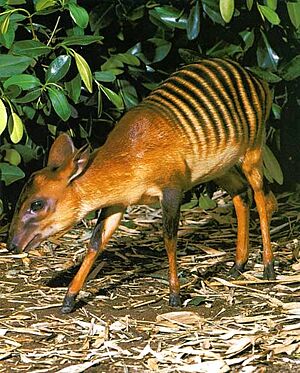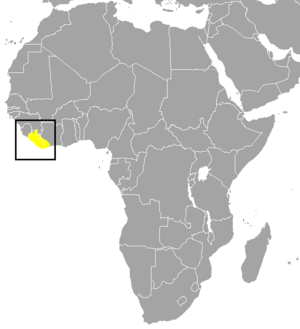Zebra duiker facts for kids
Quick facts for kids Zebra duiker |
|
|---|---|
 |
|
| Conservation status | |
| Scientific classification | |
| Genus: |
Cephalophus
|
| Species: |
zebra
|
 |
|
| Distribution of zebra duiker | |
The zebra duiker (Cephalophus zebra) is a small antelope. It lives mainly in Liberia. You can also find it in the Ivory Coast, Sierra Leone, and sometimes Guinea. People sometimes call it the banded duiker or striped-back duiker. Scientists believe it is one of the oldest duiker species to have evolved.
Contents
About the Zebra Duiker's Name
The scientific name for the zebra duiker is Cephalophus zebra. It belongs to a group of animals called Cephalophus. This group is part of the Bovidae family, which includes cows and goats.
A British scientist named John Edward Gray first described this animal in 1838. The name Cephalophus likely comes from two old words. "Cephal" means head, and "lophos" means crest. The name zebra was chosen because of the duiker's stripes. These stripes make it look a lot like a zebra.
The word "duiker" comes from an Afrikaans word. It means "diver." This is because duikers often dive into thick bushes when they feel scared. In Liberia, people sometimes call the zebra duiker the "marking deer."
How Zebra Duikers Are Related to Other Animals
|
||||||||||||||||||||||||||||||||||||
| Family tree of duikers (Johnston et.al. 2012) |
Scientists study animal DNA to understand how different species are related. In 2012, researchers looked at the DNA of duikers. They found that the zebra duiker is closely related to the bay duiker and Jentink's duiker. These duikers likely developed into separate species a long time ago.
What Zebra Duikers Look Like
Zebra duikers have beautiful coats. They are gold or reddish-brown. They have 12 to 16 clear stripes, just like a zebra. They also have dark marks on their upper legs. Their faces are a reddish color.
When they are born, baby duikers look darker. Their stripes are also closer together. An adult zebra duiker can grow to about 90 cm (35 in) long. They stand about 45 cm (18 in) tall. They can weigh around 20 kg (44 lb).
Their horns are short and rounded. They have sharp, pointed tips. Male duikers have horns about 4.5 to 5.0 cm (1.8 to 2.0 in) long. Female duikers have horns that are about half that size. Female duikers are usually bigger than males. This might be because they carry their babies for a long time.
Where Zebra Duikers Live
Zebra duikers live in lowland rainforests. They especially like areas near clearings. They also live along the edges of forests. You will most often find them in the forested parts of midwestern Africa. Sometimes, they can be found in forests on hills and low mountains.
What Zebra Duikers Eat
Zebra duikers are plant-eaters. They mainly eat fruit, leaves, and seeds. They are ruminants, which means they chew their food twice. This helps them digest tough plant material.
Sometimes, they might even eat small rodents. This is rare, but it has been seen. Their noses have strong bones. This helps them crack open the hard shells of some fruits.
Reproduction and Life Cycle
The mother zebra duiker carries her baby for a long time. This period is called gestation. It lasts from 221 to 229 days. After giving birth, the mother can get pregnant again in about 10 days.
A mother duiker usually has only one baby at a time. A newborn baby weighs about 1,270 to 1,550 grams (2.8 to 3.4 lb). For the first ten days, the baby grows very fast. It gains about 94 grams (3.3 oz) each day. After that, its growth slows down.
Female duikers can start having babies when they are 9 to 12 months old. Males can start breeding when they are 12 to 18 months old.
How Zebra Duikers Behave
Zebra duikers are mostly active during the day when they are in zoos. But in the wild, they are usually active at night. They are shy animals.
They are mostly solitary animals. This means they live alone. However, a male and female will form a pair to breed. Both parents help protect their baby and their home area.
Their stripes help them hide from predators. The stripes can break up their shape, making it harder to see them. Their strong nose bones also protect them. These bones help them if they get into fights.
Why Zebra Duikers Are Important to People
People sometimes hunt zebra duikers for their meat. This meat is called bushmeat. Their hides (skins) and other parts can also be used by humans.
Protecting Zebra Duikers
Zebra duikers are considered a vulnerable species. This means they are at risk of disappearing. They face many threats. One big problem is deforestation. This is when forests are cut down, destroying their homes. They are also overhunted by people.
Many animals hunt zebra duikers. These include African leopards, African golden cats, rock pythons, and crowned eagles. Some baboons and chimpanzees also hunt small antelopes like the zebra duiker.
Scientists say that zebra duikers are not very good at adapting to changes in their environment. This makes them more likely to become extinct. There are about 28,000 zebra duikers left in the wild. But this number is believed to be decreasing.
Zebra duikers are now more common in protected areas. These places include the Gola National Park in Sierra Leone. They also live in Sapo National Park in Liberia and Taï National Park in Ivory Coast. Efforts are being made to protect more areas where they live.


